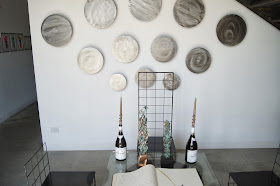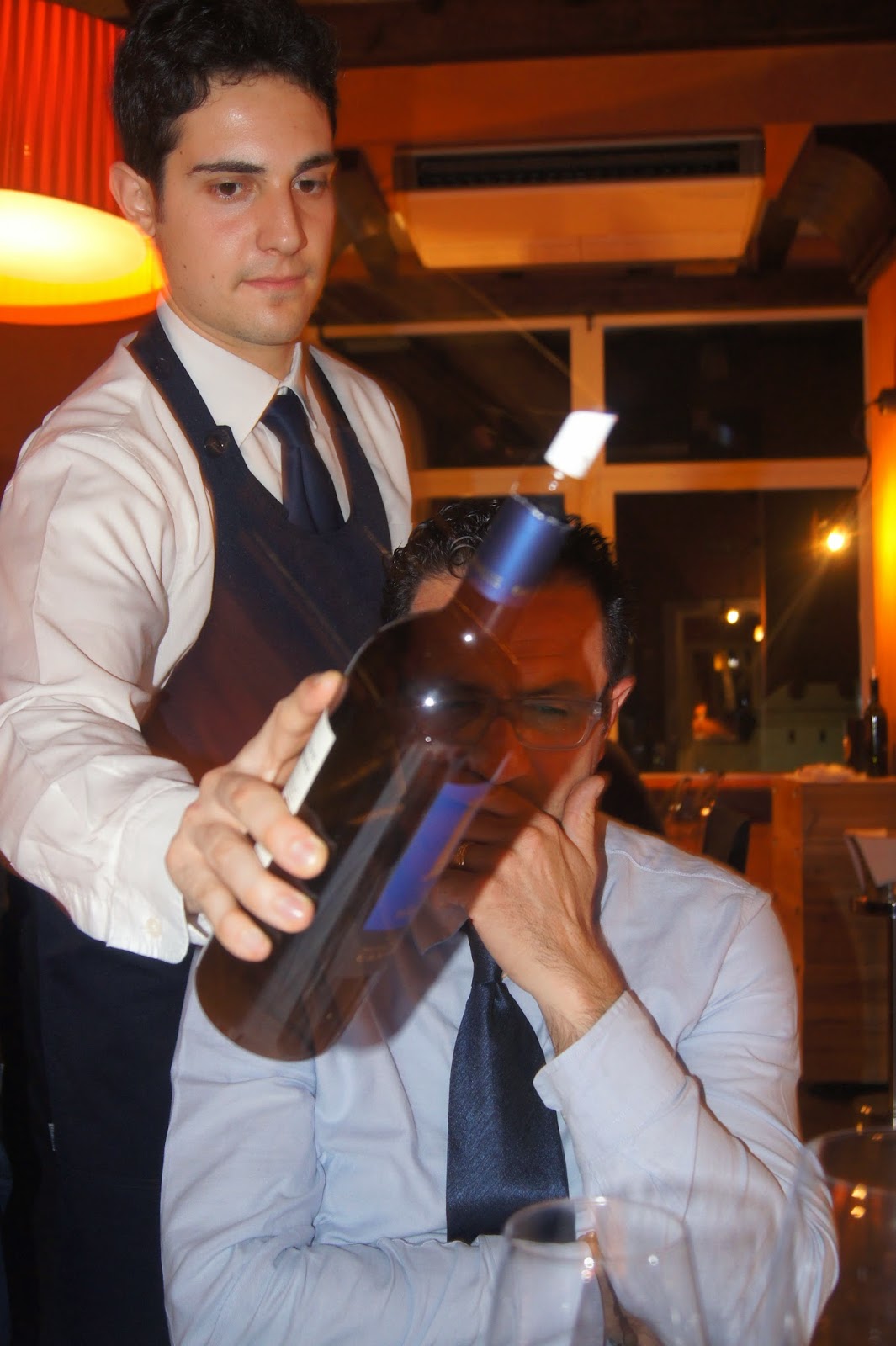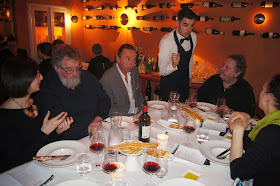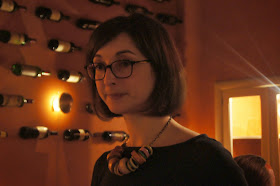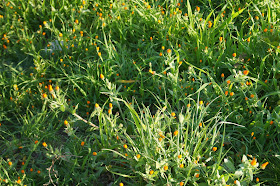by Dwight Casimere
VERONA, Italty--In 1957, an ambitious young winemaker, Franco Ziliani, was given a mission by wine estate owner Guido Berlucchi; develop a fine sparkling wine in the Metodo Classico style that would be worthy of the highest classification, according to local Italian wine law. The result was Berlucchi Franciacorta Brut and the rest, as they say, is history.
Since 2003, Franciacorta has been the only Italian wine not obliged to declare its DOCG appellation on the label, in the same manner that French Champagne is permitted to exclude a similar distinction from its label. The comparison doesn't stop there, The sparkling wine, with its fine persistent bubbles and delightful fragrance, is as fine as any from France.
Berlucchi Franciacorta Brut greets you with the aroma of fresh cut white flowers and the flavor of crisp Golden Delicious apples. Further notes of ripe pear, pineapple and star fruit, make it the perfect apperitif. The lingering note of cinnamon spice on the tongue makes it possible to carry it on into the meal. Lightly poached salmon or sauteed scallops drizzled with blood orange juice or couscous with grilled vegetables, Cobb Salad or pasta primavera as a light spring brunch, come to mind.
Franciacorta is a unique sparkling wine from Lombardy and most of the great sparkling wine in the region comes from the Berlucchi estate. 100% Franciacorta fruit spends 18 months fermenting before it is disgorged to reveal its full elegance. The light, fragrant nose, crisp, rich taste and appealing appearance and mouth feel make it the perfect guest at your first formal brunch table of the season!
Tuesday, March 25, 2014
Friday, March 21, 2014
Tenute di Emera: Discovering the art and history of wine
Story and photo gallery by Dwight Casimere
GUAGNO, Puglia, Italy---Entering the winery Tenute di Emera one would appear to be entering a spac emore like Terra Museum or a private art museum than a winery. The outer courtyard is dominated by a huge outdoor sculpture complete with an inscription from Homer's The Illiad. The interior is filled with artifacts witnessing the founding of the region by Greece and its indelible imprint in the planting of the first wine grapes, which came to be known as Negroamaro, the wine varietal exclusive to Puglia.
The wine tasting room is dominated by a free-hand mural created by the artist Ercole Pignatelli. Emera's winemaster, Claudio Quarta, has been recognized by Gambero Rosso, the Italian culinay institute and media conglomerate for his oontributions to the scientific advancement of viticulture.
The winery's award-winning "Wall of Respect" reflecting its Gambero Rosso honor of 2013
Polish online wine journalist Marta Wrzesniewska in the aging cellar which is an integral part of the art gallery
Alessandra Quarta the Marketing and Exports Manager
The mural in the tasting room by the artist Ercole Pignatelli
Tenute di Emera began in 2003 when Claudio Quarta bought an estate near Pulsano, the homeland of the indigenous varietal Primitivo di Manduria.Utilizing the superb vineyards along the idyllic Salento Ionian coast, he began to make wines of distinction.Using the existing 16th century "masseria," or farmhouse, he created a unique winemaking facility that combined the latest in technology with the winery's architectural and farming history. On the cutting edge of viticulture, the winery is in the midst of an ambitious project to recoup ancient and extinct varieties of grapes, and to compare different vines. Currently, the winery and its vineyards are home to 500 grape varieties from around the world.
Scenes at Tenute di Emera
Alessandra Quarta with Dwight The Wine Doctor
The wines of Tehute di Emera:
Anima di Primitivo-$13
Manduria is the spiritual home of Primitivo, even if it is thought to have originated somewhere near Croatia and may, in fact, be the same grape varietal, or, at least the kissing cousin of California Zinfandl. Called "primitivo" because it is the first (prime) grape to ripen in the harvest cycle (as is Tempranillo), ths is the most widely planted grape in southeastern Italy. Puglia is located in "the heel of the boot", where Primitivo is its most planted grape. Here, this inky, tannic wine finds its expression in a medium bodied wine, Ruby-red in color, with the fragrance of crushed red roses, and flavors of Bing cherries, licorice and plums. Long nd intense on the palate, it can be served slightly chilled. Its right at home with barbecue and grilled meats and loves slow-cooked meats, hams and other cured meats.
Emera Rose Lizzano Negroamaro Rosato=$12
GUAGNO, Puglia, Italy---Entering the winery Tenute di Emera one would appear to be entering a spac emore like Terra Museum or a private art museum than a winery. The outer courtyard is dominated by a huge outdoor sculpture complete with an inscription from Homer's The Illiad. The interior is filled with artifacts witnessing the founding of the region by Greece and its indelible imprint in the planting of the first wine grapes, which came to be known as Negroamaro, the wine varietal exclusive to Puglia.
The wine tasting room is dominated by a free-hand mural created by the artist Ercole Pignatelli. Emera's winemaster, Claudio Quarta, has been recognized by Gambero Rosso, the Italian culinay institute and media conglomerate for his oontributions to the scientific advancement of viticulture.
The sculpture garden at Tenute di Emera
The winery's award-winning "Wall of Respect" reflecting its Gambero Rosso honor of 2013
Polish online wine journalist Marta Wrzesniewska in the aging cellar which is an integral part of the art gallery
Alessandra Quarta the Marketing and Exports Manager
The mural in the tasting room by the artist Ercole Pignatelli
Tenute di Emera began in 2003 when Claudio Quarta bought an estate near Pulsano, the homeland of the indigenous varietal Primitivo di Manduria.Utilizing the superb vineyards along the idyllic Salento Ionian coast, he began to make wines of distinction.Using the existing 16th century "masseria," or farmhouse, he created a unique winemaking facility that combined the latest in technology with the winery's architectural and farming history. On the cutting edge of viticulture, the winery is in the midst of an ambitious project to recoup ancient and extinct varieties of grapes, and to compare different vines. Currently, the winery and its vineyards are home to 500 grape varieties from around the world.
Scenes at Tenute di Emera
Alessandra Quarta with Dwight The Wine Doctor
The wines of Tehute di Emera:
Anima di Primitivo-$13
Manduria is the spiritual home of Primitivo, even if it is thought to have originated somewhere near Croatia and may, in fact, be the same grape varietal, or, at least the kissing cousin of California Zinfandl. Called "primitivo" because it is the first (prime) grape to ripen in the harvest cycle (as is Tempranillo), ths is the most widely planted grape in southeastern Italy. Puglia is located in "the heel of the boot", where Primitivo is its most planted grape. Here, this inky, tannic wine finds its expression in a medium bodied wine, Ruby-red in color, with the fragrance of crushed red roses, and flavors of Bing cherries, licorice and plums. Long nd intense on the palate, it can be served slightly chilled. Its right at home with barbecue and grilled meats and loves slow-cooked meats, hams and other cured meats.
Emera Rose Lizzano Negroamaro Rosato=$12
Negroamaro has been grown in this region for hundreds of years, but it was only in 1988 that the DOC, from which it comes, was created. This medium textured wine is created from hand-picked grapes that are allowed to macerate on the skins while being gently pressed, thus giving the wine its bright, coral highlights. Floral notes, Meyer lemon, a hint of Mandarin or Clementine orange and a mouthful of pleasant blueberry and cherry flavors make this a great wine, well-chilled, with fish. The long finish simply cries for fresh Salmon!
A blend of grapes grown in Salento, including the native grapes Negroamaro and Primitivo, combined with the international varieties of Merlot, Shiraz and Cabernet, this is a big red wine with intense Ruby color and juicy red fruit flavors of black plums and currants. There's a hint of vanlla and cinnamon baking spice, but no wood was used in the aging of this wine. It's all wrapped in stainless steel from start to finish, so what you're tasting all comes from the fruit. A touch of sage and oregano gives the wine complexity and balance. Its best with aged cheeses and a really good piece of steak or herb encrusted lamb.
A Michelin--starred day and night in Puglia
Story and photo gallery by Dwight Casimere
CONVERSANO, Puglia--A sincere passion for the land, and an embracing of the culinary traditions of the Puglia wine region, are the driving forces behind Pasha Ristorante. Executive Chef Maria Cicorella and her son, Antonello Magita', the manager and Matre 'd make it the embodiment class and sophisticated service.
On a night awash with the glow of a full-moon, my party of international wine and travel journalists were treated to an evening of gastronomic delight. The seasonal delights of cucina tradizione pugliese, as interpreted by Chef Maria Cicorella and her culinary staff created a culinary landscape. The seven-course meal featured local delicacies such as smoked stracciatella cheese, Mullet filet, local foie gras and hand-made orecchietta pasta. The primary focus was a superb locally grown Rabbit smothered in shavings of white truffle from the nearby town of Basilicata. Wines from Castel di Salve from their nearby estates at Monteroni, Ugento and Supersano, accompanied the finely crafted meal.
Francesca Rizzi presents her Castel di Salve Armecolo wine
Antonello Magistà dispays the unique presentation of the smoked stracciatella, in which billows of smoke roll forth from the plate
An intermezzo from the kitchem
Farfalle pasta covered with fresh, local ricotta cheese, smothered in locally sourced sea urchin
Almond and orange souffle' with bitter chocolate sauce
Francesca Rizzi of Castel di Salve
Smoke billowed from the plate as Antonello Magista' ceremoniously removed the white ceramic cones from the single-bite composed dish consisting of a Camomile brioche crouton, smoked stracciatella cheese, with anchovy and confit cherry tomatoes. The fresh forested wood smoke aroma and briny anchovy brought out the crushed violets and tart raspberry flavors of he luciously pink 100% Negroamaro blush wine, Santi Medici Rosato IGT-$19. The wine from Salento is made from the indigenous red grape (literally translated as Black/black from both the ancient Greek and rustic Pugliesi languages to describe the color of the grape), the juice is left in contact with the skins for 12 hours to achieve the wine's distinctive color, then cold-femented in stainless steel tanks to achieve a perfect balance of fruit and acid.
I asked for, and received an extra helping o fresh-from-the-sea, sea urchin to drape over my serving of toothsome handmade Farfalle pasta with creamy fresh local ricotta cheese nestled in march-mandarin orange fragrance. The dish was a perfect foil for the subsequent glass of Priante Rosso Salento GT-$25. The 50/50 blend of Negroamaro and Montepulciano grapes lent their juicy black fruit richness, with a hint of oak spices, to contrast nicely with the creamy mouthful and slightly sea mineral richness of the dish.
By far, the star dish of the evening was he locally sourced fresh roasted rabbit with asparagus smothered in freshly shaved white truffles. This deliciously decadent dish was dappled with a rich glaze made with rabbit stock reduction. Accompanied by Cento Su Cento 100% Negroamro red wine- $35, this was a mouthfilling gastronomic adventure.
A puffy mound of individually made Almond and orange souffle with bitter chocolate was framed by the evening's special treat; Aleatico Passito Salento IGT-$45. The 100% Aleatico grapes are laid out "passito" style to dry until they achieve a distinctive dried pruney flavor. The chewy licorice and tart plum flavors proved to be a heady experience. An approving nod to the waiter brought a second souffle. It pays to sit near the kitchen and smile a lot. Abbondanza!
For more on Pasha, visit http://www.pashaconversano.it/
CONVERSANO, Puglia--A sincere passion for the land, and an embracing of the culinary traditions of the Puglia wine region, are the driving forces behind Pasha Ristorante. Executive Chef Maria Cicorella and her son, Antonello Magita', the manager and Matre 'd make it the embodiment class and sophisticated service.
On a night awash with the glow of a full-moon, my party of international wine and travel journalists were treated to an evening of gastronomic delight. The seasonal delights of cucina tradizione pugliese, as interpreted by Chef Maria Cicorella and her culinary staff created a culinary landscape. The seven-course meal featured local delicacies such as smoked stracciatella cheese, Mullet filet, local foie gras and hand-made orecchietta pasta. The primary focus was a superb locally grown Rabbit smothered in shavings of white truffle from the nearby town of Basilicata. Wines from Castel di Salve from their nearby estates at Monteroni, Ugento and Supersano, accompanied the finely crafted meal.
AntonelloMagista' and his mother, Chef Maria Cicorella
Francesca Rizzi presents her Castel di Salve Armecolo wine
Antonello Magistà dispays the unique presentation of the smoked stracciatella, in which billows of smoke roll forth from the plate
An intermezzo from the kitchem
Farfalle pasta covered with fresh, local ricotta cheese, smothered in locally sourced sea urchin
Almond and orange souffle' with bitter chocolate sauce
Francesca Rizzi of Castel di Salve
Smoke billowed from the plate as Antonello Magista' ceremoniously removed the white ceramic cones from the single-bite composed dish consisting of a Camomile brioche crouton, smoked stracciatella cheese, with anchovy and confit cherry tomatoes. The fresh forested wood smoke aroma and briny anchovy brought out the crushed violets and tart raspberry flavors of he luciously pink 100% Negroamaro blush wine, Santi Medici Rosato IGT-$19. The wine from Salento is made from the indigenous red grape (literally translated as Black/black from both the ancient Greek and rustic Pugliesi languages to describe the color of the grape), the juice is left in contact with the skins for 12 hours to achieve the wine's distinctive color, then cold-femented in stainless steel tanks to achieve a perfect balance of fruit and acid.
I asked for, and received an extra helping o fresh-from-the-sea, sea urchin to drape over my serving of toothsome handmade Farfalle pasta with creamy fresh local ricotta cheese nestled in march-mandarin orange fragrance. The dish was a perfect foil for the subsequent glass of Priante Rosso Salento GT-$25. The 50/50 blend of Negroamaro and Montepulciano grapes lent their juicy black fruit richness, with a hint of oak spices, to contrast nicely with the creamy mouthful and slightly sea mineral richness of the dish.
By far, the star dish of the evening was he locally sourced fresh roasted rabbit with asparagus smothered in freshly shaved white truffles. This deliciously decadent dish was dappled with a rich glaze made with rabbit stock reduction. Accompanied by Cento Su Cento 100% Negroamro red wine- $35, this was a mouthfilling gastronomic adventure.
A puffy mound of individually made Almond and orange souffle with bitter chocolate was framed by the evening's special treat; Aleatico Passito Salento IGT-$45. The 100% Aleatico grapes are laid out "passito" style to dry until they achieve a distinctive dried pruney flavor. The chewy licorice and tart plum flavors proved to be a heady experience. An approving nod to the waiter brought a second souffle. It pays to sit near the kitchen and smile a lot. Abbondanza!
For more on Pasha, visit http://www.pashaconversano.it/
Monday, March 17, 2014
Puglia and its wines; drenched by Mediterranean sun, steeped in ancient history
Story and photo gallery by Dwight Casimere
CASTEL DEL MONTE, Puglia--"Our main goal is the recovery of indigenous grape varietals and the creation of affordable and drinkable wines from those grapes." Those were the emphatic words of Andrea Fabiano, export department manager for Torrevento winery, one of the leaders in the rebirth of Puglia's wine industry.
Situated in a 17th century monastery in the shadow of Castel del Monte, the winery is as embedded in the rocks that comprise the walls of its picturesque barrel cellars, as it is forged in the new era of winemaking that is propelling the wines and cuisine of Puglia around the world.
High above the winery is the Castel del Monte, the architectural octagonal jewel built by Federico II of Sveva. The true purpose behind the origin of the castle remains a mystery. Was it built as a true castle or as an instrument of magic? Federico, born in the 12th century to a papal family, lived a life beset by political turmoil. After both of his parents died at an early age, Federico was left in the care of a family which did not share a devotion to the papacy. Federico began to develop ties to Islamic beliefs. Later in life, as the Crusades began mounting their drum call among the Templar Knights in their stronghold in the Puglia region, Federico signed a treaty with the Arab Sheiks, in which he vowed not to kill them. This angered the Holy Roman Church and Federico was excommunicated. Building the octagonal fortress high above the region, and facing the city of Andria, where he was received as an emperor, this would become his sanctuary. He surrounded himself with the artists, thinkers and mystics of his time, all the while keeping a watchful eye on his papal enemies while in the company of his loyal Muslim warriors.
This and other tales of Terra di Federico were spun over a spectacular lunch of local delicacies prepared by Torrevento's culinary team, while members of the wine media and wine trade enjoyed an expansive tasting of Torrevento's delicious wines.
The buffet luncheon featured such local delicacies as an assortment of cheeses, including Mozzarella Twist, Caciocavallo and Primosale cheeses, followed by an assortment of charcuterie. Sliced eggplant rolls, Scapece's Zucchini, Potatoes and Pepper "M'pacchiuse," accompanied by a Gratin of Mushrooms and "Cardoncelli" and Meat Balls. The chef personally prepared a trio of specialties as the luncheon party arrived; "Orecchiette" pasta with Turnip Tops and Little Sausages with White Wine and Mushrooms with Chicory and Pecorino Cheese. The show stopping delicacy was his Chicory and Fava Beans Mushed, which he could be observed personally stirring to a smooth consistency prior to serving, as the crystalline wines were being poured.
The natural flavors of the food were enhanced by the use of fresh herbs and vegetables, gathered from the surrounding land, where olive trees and superb olive oil production are as much a part of tradition as the art of winemaking.
MareMosso Puglia IGT, a crisp, delicate, low-in-alcohol (10.5%), white wine, made from 100% indigenous Bombino blanco grapes, was the first to be poured. This is an excellent wine for drinking as an aperitif or with a first course of grilled vegetables, fresh fish and cheeses, as it pretty much was here. The easy-drinking style of the wine, which can be drunk young, makes it a versatile companion at lunch. Its fine, delicate bouquet and hints of white flowers and light, fruity notes made it a perfect way to open up the palate and get it ready for a sumptuous meal!
I then tasted what quickly became my favorite wine of the first 48 hours of my trip to Puglia, the Vigna Pedale, Castel del Monte DOC Riserva, a beautifully structured, Ruby red beauty made with 100% Nero di Troia indigenous grapes. The wine is lush and elegant, with Garnet jeweled inflections glinting from the glass. A bright acidity with an intense nose of crushed red roses and a mouthful of ripe red raspberries and ripe plums followed by a hint of cardamum and dried sage and bay laurel. This is a classic red wine that loves the fresh meats of the season and a groaning board of local cheeses, which were so richly provided by our hosts at Torrevento. It made the trek up the mountain to Castel del Monte seem like a flight on Gossamer wings!
Dwight The Wine Doctor with Andrea Fabiano of Torrevento
Some of the excellent wines of Torrevento
Federico II's Castel del Monte
The mysterious inner chambers of Castel del Monte
The view of Corato from Castel del Monte
The courtyard within the monument
A bust of Federico II
Fresh local Mozzarella
Potatoes and Pepper "M'pacchiuse"
Chickory and Fava Beans Mushed
"Cardoncelli" and Meat Bals
Caciocavallo Cheese, Primosale and the groaning buffet table
Assorted sliced local meats and sausages
Fresh local Riccota
Andrea Fabiano among the stainless steel fermentation tanks
Deep within the barrel aging cellars for at Torrevento
Chestnut aging barrels for Bombino bianco
French oak barrels for Chardonnay
The view of Corato and the vineyards
Facing west to Andria
The complex soil of clay, limestone and silt,which gives the grapes, and the wine, such complexity
Afinal look at Castel del Monte
CASTEL DEL MONTE, Puglia--"Our main goal is the recovery of indigenous grape varietals and the creation of affordable and drinkable wines from those grapes." Those were the emphatic words of Andrea Fabiano, export department manager for Torrevento winery, one of the leaders in the rebirth of Puglia's wine industry.
Situated in a 17th century monastery in the shadow of Castel del Monte, the winery is as embedded in the rocks that comprise the walls of its picturesque barrel cellars, as it is forged in the new era of winemaking that is propelling the wines and cuisine of Puglia around the world.
High above the winery is the Castel del Monte, the architectural octagonal jewel built by Federico II of Sveva. The true purpose behind the origin of the castle remains a mystery. Was it built as a true castle or as an instrument of magic? Federico, born in the 12th century to a papal family, lived a life beset by political turmoil. After both of his parents died at an early age, Federico was left in the care of a family which did not share a devotion to the papacy. Federico began to develop ties to Islamic beliefs. Later in life, as the Crusades began mounting their drum call among the Templar Knights in their stronghold in the Puglia region, Federico signed a treaty with the Arab Sheiks, in which he vowed not to kill them. This angered the Holy Roman Church and Federico was excommunicated. Building the octagonal fortress high above the region, and facing the city of Andria, where he was received as an emperor, this would become his sanctuary. He surrounded himself with the artists, thinkers and mystics of his time, all the while keeping a watchful eye on his papal enemies while in the company of his loyal Muslim warriors.
This and other tales of Terra di Federico were spun over a spectacular lunch of local delicacies prepared by Torrevento's culinary team, while members of the wine media and wine trade enjoyed an expansive tasting of Torrevento's delicious wines.
The buffet luncheon featured such local delicacies as an assortment of cheeses, including Mozzarella Twist, Caciocavallo and Primosale cheeses, followed by an assortment of charcuterie. Sliced eggplant rolls, Scapece's Zucchini, Potatoes and Pepper "M'pacchiuse," accompanied by a Gratin of Mushrooms and "Cardoncelli" and Meat Balls. The chef personally prepared a trio of specialties as the luncheon party arrived; "Orecchiette" pasta with Turnip Tops and Little Sausages with White Wine and Mushrooms with Chicory and Pecorino Cheese. The show stopping delicacy was his Chicory and Fava Beans Mushed, which he could be observed personally stirring to a smooth consistency prior to serving, as the crystalline wines were being poured.
The natural flavors of the food were enhanced by the use of fresh herbs and vegetables, gathered from the surrounding land, where olive trees and superb olive oil production are as much a part of tradition as the art of winemaking.
MareMosso Puglia IGT, a crisp, delicate, low-in-alcohol (10.5%), white wine, made from 100% indigenous Bombino blanco grapes, was the first to be poured. This is an excellent wine for drinking as an aperitif or with a first course of grilled vegetables, fresh fish and cheeses, as it pretty much was here. The easy-drinking style of the wine, which can be drunk young, makes it a versatile companion at lunch. Its fine, delicate bouquet and hints of white flowers and light, fruity notes made it a perfect way to open up the palate and get it ready for a sumptuous meal!
I then tasted what quickly became my favorite wine of the first 48 hours of my trip to Puglia, the Vigna Pedale, Castel del Monte DOC Riserva, a beautifully structured, Ruby red beauty made with 100% Nero di Troia indigenous grapes. The wine is lush and elegant, with Garnet jeweled inflections glinting from the glass. A bright acidity with an intense nose of crushed red roses and a mouthful of ripe red raspberries and ripe plums followed by a hint of cardamum and dried sage and bay laurel. This is a classic red wine that loves the fresh meats of the season and a groaning board of local cheeses, which were so richly provided by our hosts at Torrevento. It made the trek up the mountain to Castel del Monte seem like a flight on Gossamer wings!
Dwight The Wine Doctor with Andrea Fabiano of Torrevento
Some of the excellent wines of Torrevento
Federico II's Castel del Monte
The mysterious inner chambers of Castel del Monte
The view of Corato from Castel del Monte
The courtyard within the monument
A bust of Federico II
Fresh local Mozzarella
Potatoes and Pepper "M'pacchiuse"
Chickory and Fava Beans Mushed
"Cardoncelli" and Meat Bals
Caciocavallo Cheese, Primosale and the groaning buffet table
Assorted sliced local meats and sausages
Fresh local Riccota
Andrea Fabiano among the stainless steel fermentation tanks
Deep within the barrel aging cellars for at Torrevento
Chestnut aging barrels for Bombino bianco
French oak barrels for Chardonnay
The view of Corato and the vineyards
Facing west to Andria
The complex soil of clay, limestone and silt,which gives the grapes, and the wine, such complexity
Afinal look at Castel del Monte



